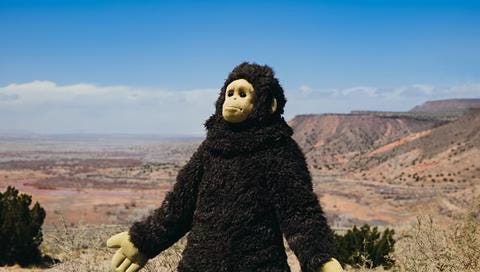Sunlight and Arts in the Desert
A look back at New Mexico through the eyes of an English director in a monkey mask.
The southwestern desert and northeastern urban landscapes have been the defining environments of my life. Though deserts are often compared to oceans and bodies of water, the pre-Socratics assure us, are so ephemeral that they cannot be waded into more than once. I find that cities change more rapidly, and in ways that better tend to catch my notice.
Over a quarter century in New York City I have watched 24-hour gyms turn into extensions of a university campus, my old office on Fifth Avenue turn into an extension of a university campus and famed nightclubs turn into an extension of a university campus. But it’s not all New York University’s fault. I’ve watched theaters turn into dog groomers and record shops turn into yoga studios, art galleries blossom and blow away and Manhattan has a whole new skyline now and they’re even turning the grungy East River Park into an oasis in the style of what they’ve had on the Hudson River side of the Island for more than 15 years now.
Somehow The Quad Cinema endures just west of Union Square, around the corner from where I used to work. It’s a real independent movie theatre that reminds me of the Jean Cocteau in Santa Fe. It’s where you see movies that you don’t see everywhere, like Sunlight, a film by Nina Conti and Shenoah Allen. Allen is from Albuquerque and is an old friend. Thirty years ago, we worked on theatrical productions together in Albuquerque. Allen devoted himself to experimental improv performance, performing solo and sometimes with partners, around the world at theatre festivals and other live venues.
Working largely in Europe and to great effect, Allen has struck up a partnership with Nina Conti, an actor, director, writer, puppeteer and artist. The two co-wrote their first feature length film and starred in it, under Conti’s direction. It’s a road movie from New Mexico to Colorado. Allen plays Roy, who we meet as a suicidally depressed radio talent. Conti saves his life. She is not suicidally depressed but is hiding from life within the confines of a monkey suit, which serves as her armor against the slings and arrows of her past abusive relationships. It’s a story of love, friendship and travel, shared by two people in close physical proximity who are separated by gulfs of hurt. It’s sad and funny and totally unique.
I’ve never met Conti, but I am somehow mildly annoyed that when I look her up, the internet (charged by AI or not) keeps telling me who her father was. I know there’s a legacy there, but she’s clearly her own artist. I do know Allen and over decades he’s adapted an acting style informed by his study of commedia dell’arte into something heightened but very real.
I started with a preamble about changing cities and the insistent desert. I haven’t been back in New Mexico in a very long time. Most of my friends and family have moved on and with limited time to see places, well, you know how it goes. So I was struck at the desert visuals in Sunlight and how familiar they are and though not a mote of sand or tumbleweed is the same as what I left, that big, hot empty remains.
True to form, Allen and Conti built their screenplay out of improvisation, sending Allen back to his home environs and introducing Conti to the American southwest. In an interview with KUNM, I thought she perfectly captured what it is to do art out there: “Well, not being from there, to me, it looked like full of personality, stunning visually, the right mixture of wily and trashy. And I just, I really enjoyed the kind of the spectrum of everything that you can find there.” It reminds me that New Mexico, even in 2025 is still full of those strange, wood-paneled rooms that seemed out of date in the 1980s, kind of like the old battleship of an RV that the couple use in their road trip. With all that’s changed over the decades, the desert communities still have a lingering Raising Arizona vibe. It’s a willingness of these communities not to “keep up” that allows for a borderlands aesthetic to endure, creating a space where an absurdist story can flourish.
New Mexico also has an infrastructure that can support a lot of creative work. The economy is always challenging but there’s a lot of land and space. The University of New Mexico is a cultural hub, both in Albuquerque and in its various properties around the state, as is St. John’s in Santa Fe and New Mexico State in Las Cruces. Two federal labs and the Santa Fe Institute bring highly credentialed academics into the community and they need cultural nourishment. Site Santa Fe is a jewel of an art museum.
I do remember wanting Albuquerque to evolve into a “next Austin” or “next Seattle” and that never quite happened despite best efforts. Instead, I witnessed a diaspora of creative people to Los Angeles, New York, the UK, and beyond while people who stayed found work in a blossoming film industry as the state wisely inked deals with Hollywood to bring feature and streaming productions to the region.
Sunlight brought up a lot for me, and it was interesting watching one artist return home with a new collaborator and an odd story to tell. Film distribution is harder than it’s ever been, especially for a movie where the woman in the monkey suit does not have monkey powers granted by radiation. But I am sure they will find a way to make Sunlight widely available for streaming. Watch for it!


